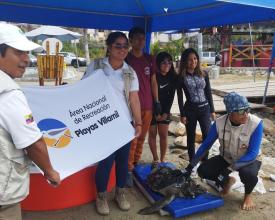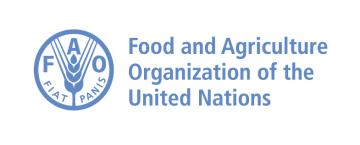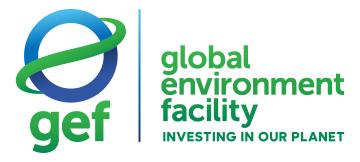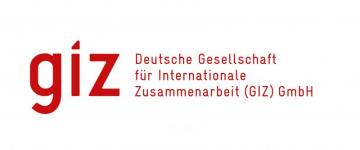
COLLABORATING FOR THE MARINE FAUNA IN PLAYAS DE VILLAMIL
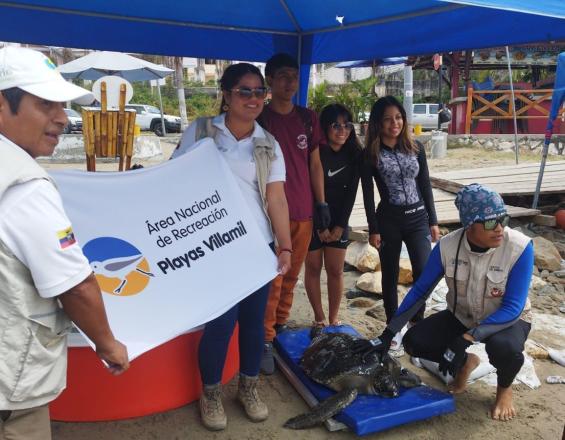
In the midst of the Covid-19 pandemic, different local actors in the province of Guayas the canton of Playas Villamil, including citizens, volunteers, officials of the Ministry of Environment, Water and Ecological Transition, and the Fundacion Juvimar “Juntos por la vida marina” joined forces to rescue the marine fauna that was stranded in the National Recreation Area Playas de Villamil and did not receive help due to the confinement that stopped all activities. Since then, the initiative has continued and strengthened its work in favor of the conservation of marine-coastal species.
Context
Challenges addressed
Environmental:
The rescue and rehabilitation of marine fauna is a complex process. These actions are especially challenging when the species present injuries produced by the affectations to their ecosystems resulting, for example, in the loss of limbs.
Social:
There is an unavoidable challenge in the coordination actions between local actors such as fishermen, volunteers and officials. It is necessary to manage the conflicts that may arise between them. Although there have been positive changes in the perception of the importance of species and their conservation, it is necessary to strengthen the processes of sensitization, education and awareness of biodiversity, marine-coastal resources and ecosystems, and protected areas.
Economic:
There is an urgent need for long-term financing to cover the costs of medicines and treatments for rescued fauna. Difficulties have been observed in obtaining and managing resources between the private sector and organizations, which puts the sustainability of the initiative at risk.
Location
Process
Summary of the process
Marine wildlife rescue is a conservation strategy that requires knowledge of the ecology of the species, as well as rigorous methods for their primary care, transfer, rehabilitation and return to their habitat. Implementing communication strategies about the species and knowing and applying the recommendations of the rescue protocol are essential tools for the success of this type of initiative.
Building Blocks
Protocole d'intervention en cas d'échouage d'espèces marines en Équateur
Outil développé par le ministère de l'environnement et le sous-secrétariat à la gestion marine et côtière. Il fournit des lignes directrices techniques et scientifiques pour le sauvetage de la faune marine dans différentes situations (espèces, site d'échouage, conditions de marée, ressources disponibles), les soins vétérinaires, la réhabilitation, la remise en liberté ou le transfert vers des centres de détention et de gestion, ou l'euthanasie et l'élimination finale. Le protocole établit également le processus de collecte et d'enregistrement des données, ainsi que le suivi de la faune sauvée.
Enabling factors
- Systématisation des informations relatives aux échouages d'espèces marines dans le profil côtier, réalisée par le ministère de l'environnement par l'intermédiaire du sous-secrétariat à la gestion marine et côtière.
- Formation du réseau équatorien d'intervention en cas d'échouage d'espèces marines,
- L'un des moyens de rendre l'application du protocole viable est la diffusion d'informations sur les cas d'échouage, par l'intermédiaire du sous-secrétariat à la gestion marine et côtière et des directions provinciales de l'environnement.
- Selon le protocole, l'Équateur dispose d'une base d'informations quantitatives et systématiques sur l'interaction des tortues marines avec les pêcheries, qui est l'un des facteurs pouvant être liés aux taux d'échouage.
Lesson learned
- Il est nécessaire d'unir les efforts pour continuer à collecter des ressources financières, ainsi que pour améliorer leur gestion. Le coût élevé du travail de sauvetage, des soins vétérinaires, de l'entretien et de la réhabilitation de la faune a été appris en cours de route.
- Il est essentiel de suivre au minimum les lignes directrices, les protocoles et les normes de gestion de la faune sauvage pour guider les relations et la construction de réseaux de coopération au fur et à mesure que l'initiative devient plus importante.
- Grâce au protocole, la communauté locale a acquis de l'expérience dans le sauvetage et la gestion de la faune marine, comprenant que la conservation est l'affaire de tous. L'inclusion des jeunes et des adultes plus âgés a été déterminante à cet égard.
- Il est nécessaire de documenter et de systématiser les processus afin de construire, de gérer et de diffuser les connaissances sur l'application de ce protocole. De cette façon, il est possible de le reproduire et de l'étendre à d'autres régions de l'Équateur ou du continent.
Formation sur le protocole d'attention rapide pour les espèces marines, destinée aux autorités environnementales. Dans ce cas, il s'agit de l'équipe des gardes forestiers.
Le protocole indique la méthodologie à suivre pour mener à bien le processus de formation : 1) identifier la liste des acteurs qui génèrent la réponse immédiate à un échouage, 2) évaluer les espèces qui s'échouent le plus fréquemment, 3) déterminer la liste des matériaux pour la construction du kit d'échouage, 4) conduire la formation théorique-pratique, qui aborde les informations identifiées dans les étapes 2 et 3.
Enabling factors
Le ministère de l'Environnement et de l'Eau de l'Équateur a organisé plusieurs sessions de formation auxquelles ont participé les gardes forestiers de cette zone protégée, ainsi que d'autres acteurs locaux et la communauté en général. Au cours de la formation, le protocole de sauvetage et d'assistance à la faune marine a été expliqué et des exercices de simulation ont été réalisés pour mettre en pratique les recommandations et les mesures établies dans le protocole.
Lesson learned
En recevant cette formation, l'équipe de gardes du parc et la communauté en général ont ratifié l'importance de connaître l'écologie des espèces (quand et comment elles nichent, par exemple), ainsi que les recommandations de base pour les sauver, les réhabiliter et les renvoyer dans leur habitat en toute sécurité.
Impacts
- The local community, particularly those involved in fishing and tourism, has become aware of the wildlife rescue work. They now report stranded fauna and clean the beaches to prevent this from happening.
- Greater acceptance, awareness, and understanding on the part of the local population regarding the declaration of the protected area (2014), which was perceived as a site of restriction and surveillance. The rescue of stranded turtles by the protected area team (before the creation of the community initiative) generated ownership of this conservation figure.
- Greater awareness of the beaches as living spaces not only for tourism, but also as a permanent habitat for birds, sea lions and turtles, among other species.
Beneficiaries
Local communities in the province of Guayas, located near the Playas Villamil National Recreation Area.
Global Biodiversity Framework (GBF)
Sustainable Development Goals
Story
Collaboration among different stakeholders is essential for the effectiveness of conservation measures.
The Covid-19 pandemic brought with it an unexpected challenge for the protection of sea turtles in the Playas de Villamil National Recreation Area. Although the park ranger team of this protected area had been rescuing two or three turtles per week since 2015, the lockdown interrupted this work. The beaches were emptied of people, but sea turtles and other species continued to arrive, and some of them became stranded there.
"It was then that the local community began to become aware of the situation. Although this place has been a protected area since 2011, the population was skeptical about it. But when they saw stranded turtles, they decided to take action. Some people offered their vehicles, while others carried the turtles short distances on foot. The sense of unity was palpable, even with the participation of elderly people who found ways to help. The pandemic was an event that changed us,” says Carlos Méndez, head of the Playas de Villamil National Recreation Area.
Soon, the need to protect that marine wildlife—which had previously gone unnoticed—began to rally support. The first turtles rescued collectively were taken to a rehabilitation center five hours away from Playas de Villamil, highlighting the need to create a local facility to care for these animals.
“In 2021, we began building our own place to care for turtles and other rescued species. With help from the community, especially retired seniors, we managed to raise funds and acquire materials. By the end of that year, the facility was already operating. The park ranger team and other members of the community received training in rescue care. Although it has been a continuous learning process, we managed to create a community support network that works hand in hand with the protected area to conserve marine wildlife.”
